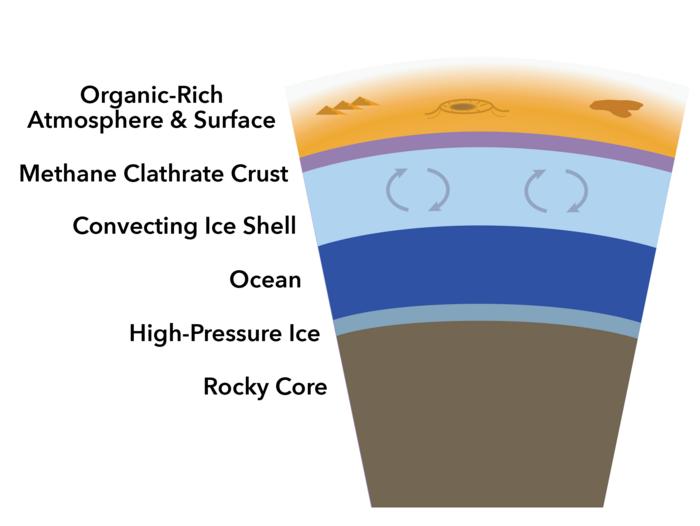
This Cassini image of Saturn’s moon Titan shows dark-colored dunes near its equator and dark-colored lakes of liquid ethane and methane near its north pole. At center is also one of the moon’s few impact craters. Credit: NASA/Cassini VIMS
The second-largest moon in our solar system may have a secret ingredient that explains many of its mysteries — and maybe ups the chances for life there.
In research published Sept. 30 in The Planetary Science Journal, a University of Hawaii-led team modeled the potential for methane clathrate (a kind of methane-infused water ice) in the crust of Titan, Saturn’s largest moon. Titan is a moon unlike any other in the solar system: it has a thick atmosphere, and its surface is dotted with lakes of hydrocarbons, making it the only world in our solar system other than Earth known to have liquid on its surface.
Strange chemistry
But some of Titan’s chemistry just shouldn’t be — methane is a volatile chemical that is easily broken down by sunlight, so its presence in the atmosphere points to some source of replenishment. The surface is relatively crater-free, meaning something must be continuously filling in impact sites. Additionally, Titan has evidence of an ocean of liquid water under its surface, which needs some kind of warming mechanism to stay liquid in the icy outer solar system.
The methane clathrate solves this: It would help keep the ice shell around Titan warm and convective, which also helps drive the methane cycle. A clathrate is a substance that can trap another chemical within it, owing to its molecular shape. In particular, Titan’s methane clathrate comprises water ice surrounding methane molecules. The methane clathrate, according to the study, likely creates a unique upper crust around Titan about 3.1 to 6.2 miles (5 to 10 kilometers) thick.
This would provide a source for replenishment of methane in the atmosphere, as well as explain how the surface shows features associated with relative warmth. In essence, a lot of the trapped methane can be slowly released, allowing atmospheric replenishment, and a warm surface would help erase evidence of most impacts from meteors, as the crust relaxes and slumps to cover holes. It could also help the ocean below the surface stay liquid — possibly providing a place for life to grow.
“Methane clathrates keep Titan’s interior warm, helping keep the subsurface liquid water ocean from freezing and promoting convection and movement in the ice shell,” Lauren Schurmeier, a researcher at the University of Hawaii and lead author of the paper, says. “If Titan’s ocean is habitable, organic materials would need to make their way from the surface down through the ice shell to the ocean.”
Schurmeier adds that the convection of the ice layers could also help transport any biosignatures — the chemical fingerprints of life — from the ocean to the world above.

Seeking answers
The last spacecraft to visit Titan was Cassini, which performed several flybys and dropped the Huygens probe to Titan before NASA intentionally crashed the craft into Saturn at the end of its operations in 2017. But there are currently plans to return to Titan via the Dragonfly mission, which received confirmation by NASA earlier this year and is undergoing development for a 2028 launch.
Related: How we landed a probe on another planet’s moon
Dragonfly, which would arrive at Titan in 2034, is a unique spacecraft. Because of Titan’s thick, hazy atmosphere, a drone could feasibly fly there. Dragonfly will have eight rotors, and NASA will send it on multiple flights covering some 50 miles (80 km) of the moon’s surface, exploring Titan’s potential for life.
The mission will also help confirm the models set forth in this paper. Gwendolyn Brouwer, a Ph.D. candidate at the University of Hawaii Manoa and an author on the paper, says the seismometer on the rotorcraft would be able to examine the thickness of the crust and, via how the signal travels, its composition compared to pure ice, which would show whether or not it contains methane clathrate.
The flight path will even take it to Selk Crater, one of the few craters on Titan’s surface, which was also examined in this study. Selk, like Titan’s other craters, is oddly shallow, and Dragonfly could help ascertain how much methane clathrates are responsible for this.
“If they are able to image the interior of the crater bowl, we should be able to see if the crater appears eroded or filled in with material such as sand from the nearby sand dunes,” Brouwer says.
If confirmed, the presence of methane clathrate would help explain a lot of the odd processes on Titan — though Dragonfly will almost certainly provide fodder for a new generation of mysteries.

